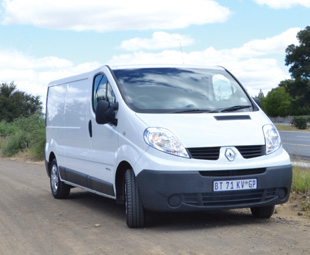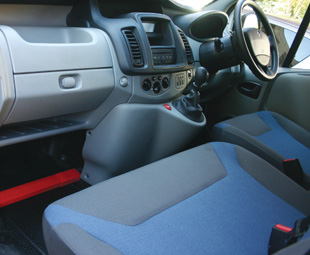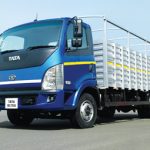Renault trades up

The Renault Trafic Panel Van 1.9 dCi is an important vehicle for the French manufacturer, which is intent on making a significant splash into the light commercial sector. SEAN PARKER assesses its potential
The previous generation Trafic was launched in this country seven years ago and came with a reputation for being a sturdy, no-nonsense light commercial vehicle (LCV). Based on the French word for “trade”, the Trafic shares its platform with the Opel Vivaro and the Nissan Primastar.
So what has Renault done to get businesses opting for the French alternative? Powered solely by a 1.9 dCi engine that produces 74 kW at 3 500 r/min and pushes out 240 Nm of torque at 2 000 r/min, this frugal diesel engine punches above its weight to deliver decent get up and go, especially considering the weight of the vehicle is pegged at just under three tonnes.
This is the same engine that powered the previous Trafic, and there is a fair amount of turbo lag – power comes in at a tad over 1 500 r/min and then stops abruptly at 2 000 r/min. The engine is mated to a six-speed manual transmission that felt notchy as I worked through the gears to best use the power at my disposal. The engine requires a fair bit of gear changing when one pilots the five-metre vehicle around town. While it is the only engine variant, one really doesn’t need any more power. Our test unit had a paltry 1 600 km on the clock, so it certainly hadn’t been run in yet. Renault claims the Trafic can consume as little as 7,9 l/100 km on the combined cycle of city and highway driving, while a decent fuel range of 870 km is attainable from the large 90-litre fuel tank. CO2 emissions are pegged at 210 g/km.
 By far the most important feature of the Trafic is the space, and boy is there loads of it. With 2 800 mm of cargo length, the Trafic stepped up to the plate when it came to moving a few large items from the office. Access to the 6 m3 loading area is via two large side-hinged doors at the rear – which open up to 180° – as well as a single sliding door on the left. Needless to say the Trafic gobbled up quite a few items. It has a payload of 1 200 kg, ample for the needs of most businesses. Side anchorage points are provided to make sure goods are securely fastened while in transit.
By far the most important feature of the Trafic is the space, and boy is there loads of it. With 2 800 mm of cargo length, the Trafic stepped up to the plate when it came to moving a few large items from the office. Access to the 6 m3 loading area is via two large side-hinged doors at the rear – which open up to 180° – as well as a single sliding door on the left. Needless to say the Trafic gobbled up quite a few items. It has a payload of 1 200 kg, ample for the needs of most businesses. Side anchorage points are provided to make sure goods are securely fastened while in transit.
The suspension has been specially adapted to cope with the Trafic’s load-lugging ability. Renault has opted for a MacPherson-type suspension with an anti-roll bar in front, along with a flexible beam with trailing arms and Panhard rod at the rear. The manufacturer has tried to replicate the driving characteristics of a multi-purpose vehicle (MPV), but because of the ground clearance of 184 mm, the Trafic is prone to body roll.
Nifty features abound, such as maintaining a constant ride height no matter what weight is being carried; made possible by the fitment of load-sensitive hydraulic dampers and variable-rate suspension. Safety-wise, Renault hasn’t skimped – it’s kitted the Trafic out with a plethora of electronic nannies to keep you out of harm’s way. The Trafic is equipped with disc brakes all round, controlled by ABS with electronic brake force distribution (EBD) and emergency brake assist (EBA).
Moving inside, the cabin is a mixture of utility and convenience. I was surprised by the amount of comfort features Renault has been able to include. These include air-conditioning, power steering, one-touch electric windows and mirrors, a trip computer, a CD/MP3-compatible audio system, and a height-adjustable driver’s seat. And there are enough storage binnacles – one can even store A4 pages at the top of the centre console, and bulkier items in the door panels. There strangely is no overhead shelf.
 One decidedly attractive aspect of the Trafic for business owners: it’s been kitted out with vehicle security that rivals Fort Knox – including an insurance-approved Category 1 alarm and immobiliser system, Renault’s Anti-Intruder Device (RAID), remote central locking with a deadlocking function for ultimate peace of mind, and the spare wheel is fitted with an anti-theft bracket.
One decidedly attractive aspect of the Trafic for business owners: it’s been kitted out with vehicle security that rivals Fort Knox – including an insurance-approved Category 1 alarm and immobiliser system, Renault’s Anti-Intruder Device (RAID), remote central locking with a deadlocking function for ultimate peace of mind, and the spare wheel is fitted with an anti-theft bracket.
All in all, Renault has created an impressive package. Perceived build quality is very good, and it’s well-spec’d with many niceties not normally seen in this segment.
The Trafic Panel Van 1.9 dCi has a price tag of R249 900. Service intervals are at 15 000 km, and Renault’s Confiance customer care package includes a five-year/90 000 km service plan, an extensive five-year/150 000 km mechanical warranty and six-year anti-corrosion warranty. Renault Confiance also provides 24-hour roadside assistance and security, fixed-price service menu, as well as guaranteed parts availability or the offer of a mobility solution.
The South African public’s perception of French brands may have been tainted by previous experiences – particularly with regards to parts availability (parts needed to be shipped over from Europe) and high servicing costs. However, Renault has been making a concerted effort to wipe out those bad memories by offering good-value vehicles crammed full of features at competitive prices. I have no doubt that this latest offering is another step in the right direction.
Published by
Focus on Transport
focusmagsa




